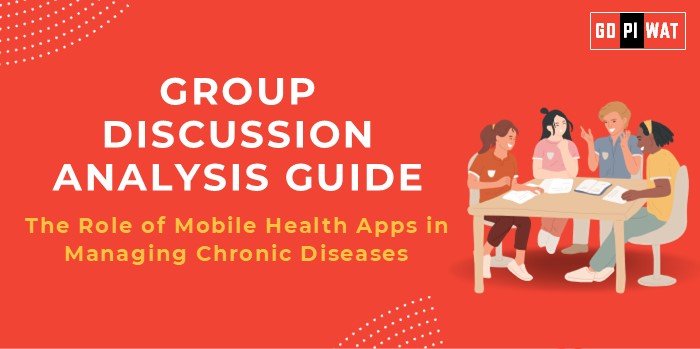📋 Group Discussion (GD) Analysis Guide: The Role of Mobile Health Apps in Managing Chronic Diseases
🌐 Introduction to the Role of Mobile Health Apps in Managing Chronic Diseases
Opening Context: “With chronic diseases accounting for 74% of global deaths annually, mobile health apps are becoming pivotal in healthcare management worldwide.”
Topic Background: These apps are designed to help patients monitor and manage conditions like diabetes, hypertension, and mental health. The COVID-19 pandemic accelerated digital health adoption, showcasing the importance of accessible healthcare technology.
📊 Quick Facts and Key Statistics
– 🩺 Chronic Disease Prevalence: 1 in 3 adults worldwide suffers from multiple chronic conditions.
– 📱 User Engagement: 58% of chronic disease patients use at least one health app for management (Source: WHO, 2023).
– 💰 Digital Health Savings: Health apps could save the global economy $46 billion annually by 2030 (McKinsey).
– 💊 Adherence Improvement: Apps improve medication adherence by 30% on average (Lancet Digital Health).
🤝 Stakeholders and Their Roles
- 👩⚕️ Patients: Primary users for condition tracking and self-management.
- 🏥 Healthcare Providers: Use apps to monitor patient data and provide personalized care.
- 💻 Tech Companies: Innovate app features and ensure data security.
- 🏛️ Government Agencies: Regulate app quality and ensure equitable access.
- 📑 Insurers: Integrate health apps into policies to encourage preventative care.
🏆 Achievements and Challenges
✨ Achievements
- ✅ Improved Patient Engagement: Apps like MyFitnessPal and DiabetesM have increased user health literacy.
- 📊 Data-Driven Insights: Apps generate actionable data for healthcare providers.
- 💰 Cost-Effectiveness: Reduced hospital visits and better self-care reduce healthcare costs.
- 🌐 Accessibility: Teleconsultation apps bridge the rural-urban healthcare gap.
⚠️ Challenges
- 🔒 Data Privacy Concerns: Breaches discourage app adoption.
- 🌍 Digital Divide: Limited access in low-income regions.
- ⚖️ Accuracy and Regulation: Poorly designed apps risk misinformation.
🌍 Global Comparisons
- 🇺🇸 US: Apps like Apple HealthKit integrate seamlessly with EMRs.
- 🇮🇳 India: Arogya Setu and similar initiatives showcase scalability but face literacy barriers.
💡 Case Studies
- 🇮🇳 India’s Apollo 24/7: Successfully integrates consultation, pharmacy, and diagnostics.
- 🇦🇺 Australia’s My Health Record: Seamlessly connects health apps to centralized data.
💬 Structured Arguments for Discussion
Supporting Stance: “Health apps have revolutionized chronic disease management, improving outcomes and reducing costs.”
Opposing Stance: “Data security and lack of standardization limit the effectiveness of health apps.”
Balanced Perspective: “While health apps enhance chronic care management, their potential depends on addressing data and access challenges.”
📚 Effective Discussion Approaches
- 📊 Opening Approaches:
- 📈 Start with Global Statistics: Highlight the prevalence of chronic diseases and health app growth.
- 🌟 Highlight Success: Mention successful apps like Apple HealthKit or Apollo 24/7.
- 🤝 Counter-Argument Handling:
- 🔍 Rebuttal: “While privacy is a concern, robust regulations like GDPR are setting benchmarks for app security.”
🔍 Strategic Analysis of Strengths and Weaknesses
– ⚠️ Weaknesses: Data privacy, rural access, regulatory inconsistencies.
– 🌟 Opportunities: AI integration, partnerships with governments.
– ⚠️ Threats: Cybersecurity risks, tech illiteracy.
📈 Connecting with B-School Applications
- 🌍 Real-World Applications: Projects on app-based healthcare delivery models.
- ❓ Sample Interview Questions:
- 💬 “How can health apps integrate with hospital systems?”
- 💡 “What regulatory measures would you propose for app safety?”
- 📖 Insights for Students:
- 🔍 Understand the market dynamics of digital health.
- 🤖 Explore the role of AI and ML in personalized healthcare.


